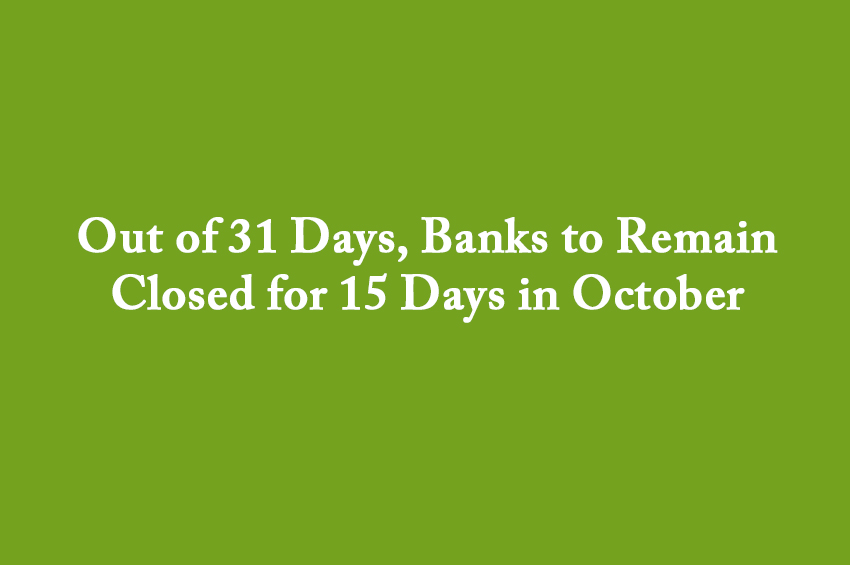Winning Bizness Desk
Mumbai. With October approaching, several major festivals like Gandhi Jayanti, Navratri, Dussehra, and Diwali are set to be observed, leading to extended bank closures across various states. According to the Reserve Bank of India's (RBI) holiday calendar, banks will be closed for about 15 days in October, including weekends and festival-related holidays.The RBI issues a list of bank holidays at the beginning of every month. For October, banks will remain closed on various dates due to regional and national holidays, as well as assembly elections in Jammu and Kashmir. Winning Bizness gives you a detailed list of holidays in the upcoming month.
Key Bank Holidays in October:
October 1: Banks in Jammu will be closed due to assembly elections.
October 2: Nationwide closure for Gandhi Jayanti.
October 3: Banks in Jaipur closed for Navratri establishment.
October 6: Nationwide closure due to Sunday.
October 10: Banks in Agartala, Guwahati, Kohima, and Kolkata closed for Durga Puja, Dussehra, and Mahasaptami.
October 11: Banks in several cities including Bengaluru, Bhubaneswar, Chennai, Guwahati, Kolkata, and others closed for Dussehra and related festivities.
October 12: Banks across most of the country closed for Dussehra, Vijayadashami, and Durga Puja.
October 13: Nationwide closure due to Sunday.
October 14: Banks in Gangtok closed for Durga Puja/Dasain.
October 16: Banks in Agartala and Kolkata closed for Lakshmi Puja.
October 17: Banks in Bengaluru and Guwahati closed for Maharishi Valmiki Jayanti and Kati Bihu.
October 20: Nationwide closure due to Sunday.
October 26: Nationwide closure due to the fourth Saturday.
October 27: Nationwide closure due to Sunday.
October 31: Nationwide closure for Diwali.
Despite the extended closures, essential banking services will still be accessible via UPI, net banking, and mobile banking. These digital platforms ensure that transactions can continue uninterrupted throughout the holiday season.
Pros and Cons of Bank Holidays In India ..
Public opinions on excessive bank holidays in India are varied, with some supporting the breaks due to cultural significance, while others express frustration due to the inconvenience. Here's a summary of common viewpoints:
Supportive Opinions:
Cultural Significance: India is a country with diverse religions and festivals, and many believe that bank holidays allow people to celebrate these occasions without worrying about work. For them, it’s a recognition of the cultural fabric of the country.
Work-Life Balance: Some argue that holidays provide bank employees much-needed rest, especially in a high-stress environment. Supporters of holidays point out that other essential services have breaks as well, and bank staff deserve the same.
Digital Alternatives: Many also point out that digital banking services have reduced the dependence on physical branches. With services like UPI, net banking, and ATMs, most daily banking tasks can be handled even on holidays.
Critical Opinions:
Inconvenience to Customers: Critics often express frustration, especially businesses and working professionals, about long or consecutive bank holidays. They argue that excessive closures can disrupt financial operations, such as processing checks, accessing locker services, and completing other in-person banking tasks.
Impact on Small Businesses: Small business owners in particular complain about cash flow issues, delays in processing payments, and the impact on business operations when banks are closed for extended periods. Even though digital alternatives exist, many rural areas or older customers still rely on physical branches.
Economic Impact: Some critics believe excessive holidays can affect the economy by delaying financial transactions and limiting access to credit or liquidity during festive seasons, which are otherwise key for spending and business growth.
Need for Reform: Some critics believe excessive holidays can affect the economy by delaying financial transactions and limiting access to credit or liquidity during festive seasons, which are otherwise key for spending and business growth.


